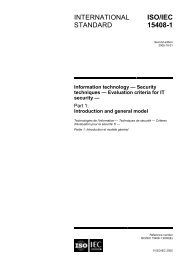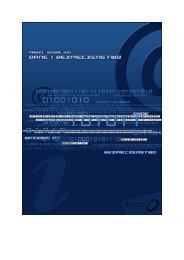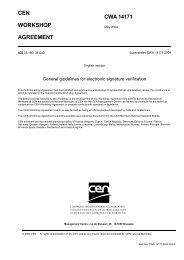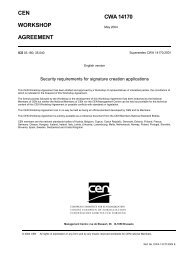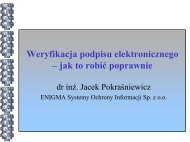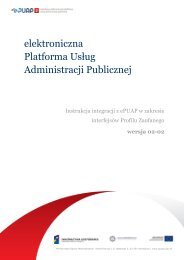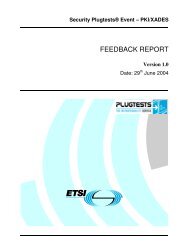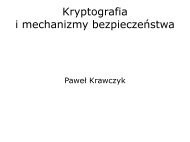When electronic signature becomes a information services ... - IPSec
When electronic signature becomes a information services ... - IPSec
When electronic signature becomes a information services ... - IPSec
You also want an ePaper? Increase the reach of your titles
YUMPU automatically turns print PDFs into web optimized ePapers that Google loves.
specific requirements are all slightly different in each of the Member States of the EU, it is<br />
virtually impossible to make a product that complies with all of them. 16 This converted the EU<br />
QES market into small national enclaves, with local companies guarding their local<br />
interpretations and regulatory secrets.<br />
As for the general architecture of the QES, Estonia is a notable exception from the negative<br />
trend. In Estonia, the government implemented a reasonably complete and consistent product<br />
(DigiDoc), which started from clearly defined objectives, an open technical specification,<br />
software packages and an internet portal. In addition, an attempt was made to invite others to<br />
consider interoperability by publishing an open implementation (OpenXAdES 17 ). Another<br />
helpful move in right direction is PDF Advanced Electronic Signatures (PAdES) (ETSI TS 102<br />
778). PAdES is interesting because it is a format that tries to solve a specific problem: secure<br />
delivery and long-term storage of <strong>electronic</strong> documents, 18 and it can also help with providing<br />
for technical interoperability. 19 Introduced ten years after Directive 1999/93/EC, implementing<br />
this standard would require the gradual reversal of all local inventions, which may take another<br />
decade to complete. At the time of the Directive, the technical nature of the concept of the<br />
digital <strong>signature</strong> was based on the X.509 security framework, and this model may no longer be<br />
interesting for anyone except for companies earning income from endless consulting and<br />
analysis of the Directive 1999/93/EC model. 20<br />
16<br />
A good example of the impossibility of making a globally available application that complies with all the relevant QES regulations<br />
is that of Adobe Acrobat, which introduced increased support for the functions required to enable the product to be compliant to QES in<br />
version 8. The product included an internal ‘library’ of options typically required by different EU Member States. This, it was hoped, would<br />
ensure compliance with local requirements. But this was not sufficient for the German regulations, which required a dedicated option to change<br />
between ‘shell’ or ‘chain’ validation models and special ISIS-MTT object identifiers (this can only be configured by an administrator by<br />
registry modifications, so the user does not see them).<br />
17 http://www.openxades.org/.<br />
18<br />
Although note the problems about the long-term archiving of digital <strong>signature</strong>s in Stefanie Fischer-Dieskau and Daniel Wilke,<br />
‘Electronically signed documents: legal requirements and measures for their long-term conservation’, Digital Evidence and Electronic<br />
Signature Law Review, 3 (2006) 40 – 44.<br />
19<br />
Technically, PAdES is a file format that is backwards compatible with the popular PDF. While the basic PDF standard (ISO 32000)<br />
defines the PKCS#7 format, the PAdES adds CAdES support to comply with QES requirements. The file format and file extension is identical.<br />
From the user’s point of view, most PDF programs should open a PAdES file even if they cannot fully verify the QES <strong>signature</strong>.<br />
20<br />
The story of QES largely resembles the Internet Protocol Security (<strong>IPSec</strong>) (this is a method for providing for the security of IP<br />
communications by authenticating and encrypting each IP packet of a data), that was introduced as complex but consistent architecture in the<br />
early 1990s with the intent of creating a universal standard for trust over the internet. Then everyone realised that the perfect and universal<br />
<strong>IPSec</strong> would not work with private IP addresses for a private network developed in accordance with RFC 1918 (Address Allocation for Private<br />
Internets). Before it was understood and became somewhat interoperable in countless bake-off meetings, the world had to use something that<br />
was not so perfect, such as Point-to-Point Tunneling Protocol (PPTP) (a Microsoft method used to implement a virtual private network, fatally<br />
flawed in first versions), and when numerous extensions to <strong>IPSec</strong> started to be published, everyone was annoyed enough to move to SSL VPN<br />
(Secure Sockets Layer Virtual Private Network).



